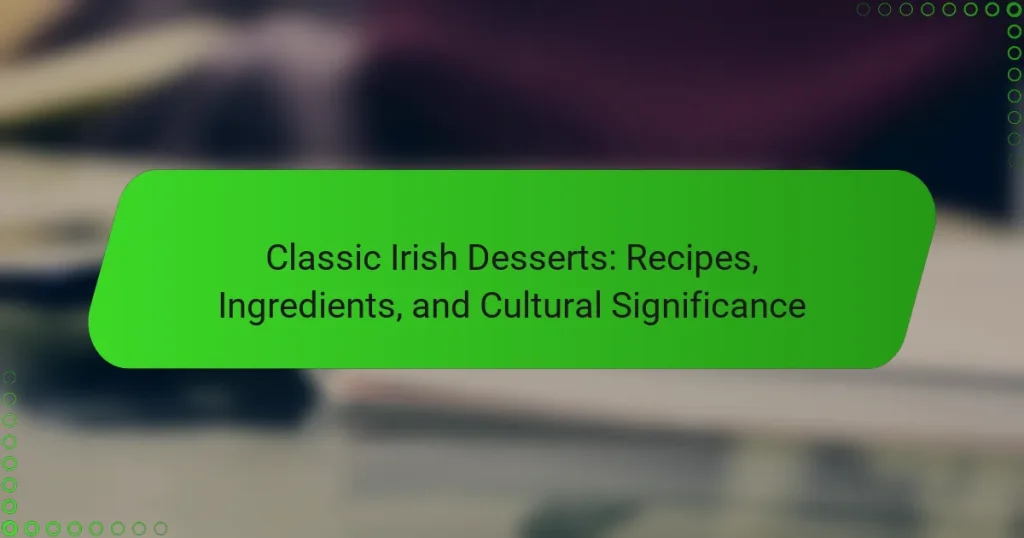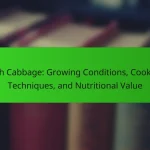Classic Irish desserts are traditional dishes that showcase Ireland’s culinary heritage, featuring recipes such as bread and butter pudding, apple tart, and Irish whiskey cake. These desserts utilize locally sourced ingredients, reflecting Ireland’s agricultural history. Key recipes include Irish Soda Bread, which is made with baking soda and buttermilk, and Baileys Cheesecake, which incorporates Irish cream liqueur. The cultural significance of these desserts lies in their role during special occasions and family gatherings, symbolizing warmth and hospitality while preserving ancestral traditions. This article explores the recipes, ingredients, and the rich cultural narrative associated with classic Irish desserts.

What are Classic Irish Desserts?
Classic Irish desserts include traditional dishes such as bread and butter pudding, apple tart, and Irish whiskey cake. Bread and butter pudding is made with layers of bread, butter, and custard. Apple tart features a flaky pastry crust filled with sweetened apples. Irish whiskey cake is a rich cake infused with whiskey and often served with cream. These desserts reflect Ireland’s agricultural heritage and the use of local ingredients. Historical records show that these desserts have been enjoyed in Irish households for generations.
How do Classic Irish Desserts reflect Irish culture?
Classic Irish desserts reflect Irish culture through their use of traditional ingredients and historical significance. Ingredients like potatoes, oats, and dairy highlight the agricultural roots of Ireland. Desserts such as soda bread and apple tart showcase local produce and regional flavors. Many classic desserts have origins in communal gatherings and celebrations, emphasizing the importance of family and community. Recipes often pass down through generations, preserving cultural heritage. Seasonal variations in desserts reflect the Irish connection to the land and its cycles. The simplicity of these desserts mirrors the Irish ethos of valuing quality over extravagance. Overall, classic Irish desserts serve as a delicious representation of Ireland’s rich cultural tapestry.
What historical influences shaped Classic Irish Desserts?
Classic Irish Desserts have been shaped by various historical influences, primarily through agriculture, trade, and cultural exchanges. The introduction of ingredients like sugar and spices in the 17th century transformed dessert recipes. Irish agricultural practices contributed to the use of local produce such as apples, berries, and dairy. The Great Famine in the 19th century shifted dessert consumption patterns, leading to resourcefulness in using available ingredients. British colonial influence also introduced new baking techniques and dessert styles, merging with traditional Irish practices. This blend created unique desserts that reflect Ireland’s rich culinary history.
How do regional variations impact Classic Irish Desserts?
Regional variations significantly impact Classic Irish Desserts by influencing ingredients and preparation methods. Different regions of Ireland utilize locally sourced ingredients, which alters the flavor profile of desserts. For example, coastal areas may incorporate seaweed or seafood, while inland regions might focus on dairy and grains. Traditional recipes, such as bread and butter pudding or apple tart, often reflect these local ingredients. Additionally, cultural influences from neighboring countries can introduce unique twists. Historical trade routes also played a role in the exchange of culinary practices. Consequently, regional specialties emerge, showcasing the diversity within Irish dessert traditions.
What are the common ingredients used in Classic Irish Desserts?
Common ingredients used in Classic Irish Desserts include flour, sugar, butter, and eggs. Flour serves as the primary structure for many desserts. Sugar adds sweetness and enhances flavor. Butter contributes richness and moisture to the recipes. Eggs are essential for binding ingredients and providing texture. Other frequently used ingredients are cream, milk, and various fruits like apples and berries. Traditional Irish desserts often incorporate spices like cinnamon and nutmeg for added warmth. Additionally, ingredients like whiskey or stout may be used in certain recipes for a distinctive flavor profile. These components reflect the agricultural heritage and culinary traditions of Ireland.
Which dairy products are essential in Classic Irish Desserts?
Butter, cream, and buttermilk are essential dairy products in Classic Irish Desserts. Butter adds richness and flavor to baked goods like cakes and scones. Cream is often used in custards and toppings, enhancing texture and taste. Buttermilk contributes to the moisture and tang in recipes like Irish soda bread. These dairy products are integral to the traditional preparation of desserts such as bread and butter pudding and apple tart. Their use is rooted in Irish culinary history, reflecting the country’s agricultural practices.
What role do grains and flours play in these desserts?
Grains and flours are fundamental components in classic Irish desserts. They provide structure and texture to various sweet dishes. Common grains include wheat, oats, and barley. Flour derived from these grains acts as a binding agent in recipes. It helps in achieving the desired consistency and moisture level. Additionally, grains contribute to the nutritional profile of the desserts. They offer fiber and essential nutrients, enhancing the overall health benefits. Traditional Irish desserts often feature specific flours, such as wholemeal flour, which adds a distinct flavor. This incorporation of grains and flours reflects the agricultural heritage of Ireland.
How are Classic Irish Desserts traditionally prepared?
Classic Irish desserts are traditionally prepared using simple, locally sourced ingredients. Common components include flour, sugar, butter, and dairy products. Recipes often feature fruits like apples, berries, and currants. Techniques such as baking, boiling, or steaming are frequently employed. For example, bread and butter pudding is baked with layers of bread and custard. Another classic, apple tart, involves layering sliced apples in a pastry crust. Desserts are typically sweetened with sugar or honey. Many recipes have been passed down through generations, reflecting Ireland’s culinary heritage.
What are the typical cooking methods for Classic Irish Desserts?
Typical cooking methods for Classic Irish Desserts include baking, boiling, and steaming. Baking is commonly used for desserts like soda bread and cakes. Boiling is often employed for traditional dishes such as bread and butter pudding. Steaming is utilized for desserts like Christmas pudding. These methods reflect the historical cooking practices in Ireland. Each method contributes unique textures and flavors to the desserts. For example, baking creates a crusty exterior, while boiling results in a moist consistency. These techniques have been passed down through generations, showcasing Irish culinary traditions.
How do traditional baking techniques influence the final product?
Traditional baking techniques significantly influence the final product in terms of texture, flavor, and appearance. Techniques such as slow fermentation enhance the development of complex flavors in bread. This process allows yeast to work over time, resulting in a richer taste. Hand-kneading, commonly used in traditional methods, creates a unique texture by developing gluten. The use of specific ingredients, like buttermilk in Irish soda bread, contributes to a distinct flavor profile. Additionally, baking at lower temperatures can produce a crust that is both crispy and chewy. These methods have been passed down through generations, ensuring cultural authenticity in classic Irish desserts. The combination of these techniques results in products that are not only delicious but also reflect a rich culinary heritage.

What are some popular recipes for Classic Irish Desserts?
Popular recipes for classic Irish desserts include Irish Soda Bread, Bread and Butter Pudding, and Baileys Cheesecake. Irish Soda Bread is a traditional bread made with baking soda instead of yeast. It often contains buttermilk, giving it a unique flavor. Bread and Butter Pudding is a comforting dish made from layers of buttered bread, raisins, and a custard mixture. Baileys Cheesecake incorporates the famous Irish cream liqueur into a rich, creamy filling on a biscuit base. These desserts reflect Ireland’s culinary heritage and are enjoyed during special occasions and gatherings.
How can I make a classic Irish Soda Bread?
To make a classic Irish Soda Bread, combine 4 cups of all-purpose flour, 1 teaspoon of baking soda, and 1 teaspoon of salt in a bowl. Mix these dry ingredients thoroughly. Next, make a well in the center and pour in 1 ¾ cups of buttermilk. Stir the mixture gently until a dough forms. Transfer the dough to a floured surface and knead it lightly for about 1 minute. Shape the dough into a round loaf and place it on a baking sheet. Cut a deep cross on the top of the loaf to help it rise. Bake in a preheated oven at 425°F (220°C) for 30-35 minutes. The bread is done when it sounds hollow when tapped on the bottom. Classic Irish Soda Bread is traditionally served warm, often with butter.
What ingredients do I need for Irish Soda Bread?
To make Irish Soda Bread, you need four main ingredients. The primary ingredients are all-purpose flour, baking soda, salt, and buttermilk. All-purpose flour is the base of the bread. Baking soda acts as the leavening agent. Salt enhances the flavor of the bread. Buttermilk provides moisture and acidity, which helps the bread rise. These ingredients combine to create a traditional Irish Soda Bread, which is quick to prepare and does not require yeast.
What are the step-by-step instructions for baking Irish Soda Bread?
Preheat the oven to 425°F (220°C). In a large bowl, mix 4 cups of all-purpose flour, 1 teaspoon of baking soda, and 1 teaspoon of salt. Create a well in the center of the dry ingredients. Pour in 1 ¾ cups of buttermilk into the well. Stir until a soft dough forms. Turn the dough onto a floured surface and knead gently for about 30 seconds. Shape the dough into a round loaf, about 1.5 inches thick. Place the loaf on a baking sheet lined with parchment paper. Cut a deep cross in the top of the loaf using a sharp knife. Bake for 30-40 minutes until the bread is golden brown. The bread is done when it sounds hollow when tapped on the bottom. Allow the bread to cool on a wire rack before slicing.
What is the recipe for Baileys Cheesecake?
To make Baileys Cheesecake, you need the following ingredients: 250g digestive biscuits, 100g unsalted butter, 600g cream cheese, 150g icing sugar, 300ml double cream, and 150ml Baileys Irish Cream. First, crush the digestive biscuits into fine crumbs. Melt the unsalted butter and mix it with the biscuit crumbs. Press this mixture into the base of a springform cake tin. In a bowl, beat the cream cheese and icing sugar until smooth. Gradually add the double cream and Baileys, mixing until combined. Pour this mixture over the biscuit base. Chill the cheesecake in the refrigerator for at least four hours or overnight. Once set, decorate as desired before serving. This recipe reflects the rich flavors associated with Irish desserts.
What ingredients are necessary for Baileys Cheesecake?
The ingredients necessary for Baileys Cheesecake include cream cheese, sugar, heavy cream, Baileys Irish Cream, and a graham cracker crust. Additionally, eggs are required for the filling to provide structure. Vanilla extract enhances the flavor. Chocolate shavings can be used for garnish. Each ingredient contributes to the rich, creamy texture and unique taste of the cheesecake.
How long does it take to prepare and bake Baileys Cheesecake?
Preparing and baking Baileys Cheesecake takes approximately 2 to 3 hours. The preparation time typically ranges from 30 to 45 minutes. Baking the cheesecake usually requires about 60 to 75 minutes. After baking, it is essential to chill the cheesecake for at least 4 hours, ideally overnight, before serving. This chilling time allows the flavors to meld and the texture to set properly. Therefore, while the active time is relatively short, the total time from preparation to serving can extend to several hours.
What are the steps to create a traditional Apple Tart?
To create a traditional Apple Tart, start by preparing the pastry. Combine flour, butter, sugar, and salt in a bowl. Mix until it resembles breadcrumbs. Add cold water gradually until the dough forms. Wrap the dough in plastic and chill for at least 30 minutes.
Next, preheat the oven to 375°F (190°C). Roll out the chilled pastry on a floured surface. Place the pastry into a tart tin and trim the edges.
For the filling, peel and slice apples. Toss them with sugar, cinnamon, and lemon juice. Arrange the apple slices evenly over the pastry.
Bake the tart for 30 to 35 minutes until the apples are tender and the pastry is golden. Allow it to cool before serving. This recipe is based on traditional methods passed down through generations in Irish cuisine.
What types of apples are best for an Irish Apple Tart?
The best types of apples for an Irish Apple Tart are Bramley and Granny Smith. Bramley apples are known for their tartness and ability to hold shape when cooked. They provide a rich flavor that complements the sweetness of the tart. Granny Smith apples also offer a tart profile, making them ideal for balancing sweetness in desserts. Both varieties have a firm texture, which is essential for maintaining structure in the tart. Their acidity enhances the overall taste, ensuring a well-rounded dessert.
How do I achieve the perfect crust for an Apple Tart?
To achieve the perfect crust for an apple tart, use a combination of flour, butter, and cold water. Start with all-purpose flour for the base. Cut in cold, unsalted butter until the mixture resembles coarse crumbs. This technique ensures a flaky texture. Gradually add cold water to form a dough. Chill the dough for at least 30 minutes before rolling it out. This resting period helps the gluten relax, resulting in a tender crust. Roll the dough to about 1/8 inch thickness for optimal baking. Transfer the dough to the tart pan carefully to avoid tearing. Prick the bottom with a fork to prevent bubbling during baking. Pre-bake the crust for 10-15 minutes before adding the apple filling to ensure it stays crisp.

What is the cultural significance of Classic Irish Desserts?
Classic Irish desserts hold significant cultural importance as they reflect Ireland’s history and traditions. These desserts often incorporate locally sourced ingredients like dairy, fruits, and grains. Traditional recipes have been passed down through generations, preserving Irish culinary heritage. Celebratory occasions frequently feature these desserts, emphasizing their role in community and family gatherings. Dishes such as bread pudding and apple tart are not just food; they symbolize warmth and hospitality in Irish culture. Furthermore, they connect people to their ancestry and regional identities. The recipes often tell stories of the land and its people, making them a vital part of Ireland’s cultural narrative.
How do Classic Irish Desserts play a role in Irish celebrations?
Classic Irish desserts are integral to Irish celebrations. They symbolize cultural heritage and community bonding. Traditional desserts like soda bread, apple tart, and bread pudding are often featured during holidays and family gatherings. For example, apple tart is commonly served at harvest festivals, celebrating the abundance of local produce. Desserts also mark significant events like weddings and Christmas, where treats such as cake and custard are customary. These desserts evoke nostalgia and create a sense of belonging among families. Overall, classic Irish desserts enhance the festive atmosphere and reinforce cultural traditions.
What desserts are traditionally served during Irish holidays?
Traditional desserts served during Irish holidays include Irish soda bread, bread pudding, and apple tart. Irish soda bread is often enjoyed on St. Patrick’s Day. Bread pudding, made from leftover bread, is a common comfort food during celebrations. Apple tart is frequently prepared for various holidays, showcasing Ireland’s abundant apple harvest. These desserts reflect the country’s culinary heritage and seasonal ingredients.
How are desserts used in family gatherings and community events?
Desserts play a significant role in family gatherings and community events. They serve as a focal point for celebration and sharing. Traditional desserts often evoke nostalgia and cultural heritage. In Irish culture, desserts like bread pudding and apple tart are commonly served. These desserts foster connections among family members and friends. They encourage conversations and create a warm atmosphere. Sharing desserts also symbolizes hospitality and generosity. This practice strengthens community bonds during events like festivals and holidays.
What stories and folklore are associated with Classic Irish Desserts?
Classic Irish desserts are often intertwined with rich stories and folklore. One popular tale involves the creation of bread pudding, which is said to have originated from the need to avoid waste. Families would use leftover bread and combine it with milk and eggs, creating a dish that became a staple. Another story centers around the tradition of making apple tart, linked to the harvest season. It symbolizes abundance and is often shared during family gatherings. Additionally, the lore of the “Barmbrack,” a fruitcake associated with Halloween, includes hidden charms that predict the future of those who find them. These narratives highlight the cultural significance of desserts in Irish heritage.
How do these stories enhance the appreciation of Irish Desserts?
Stories enhance the appreciation of Irish desserts by providing cultural context and historical significance. They connect people to the traditions and heritage behind each dessert. For example, tales of family gatherings often highlight the role of desserts in celebrations. This emotional connection fosters a deeper understanding of the recipes and ingredients used. Additionally, stories about the origins of specific desserts can reveal unique regional variations. These narratives enrich the overall experience of enjoying Irish desserts. They transform simple recipes into cherished memories and cultural symbols. Thus, stories serve as a bridge between past and present, enhancing appreciation for these culinary delights.
What are some famous legends related to specific desserts?
Famous legends related to specific desserts often highlight their cultural significance. One notable legend is that of the Barmbrack, a traditional Irish fruitcake. It is said that the cake is associated with Samhain, an ancient festival marking the end of the harvest season. During this festival, various items were hidden in the Barmbrack to predict the future of those who found them.
Another legend involves the origins of Irish Soda Bread. It is believed that the bread was created by early Irish settlers using baking soda as a leavening agent. The cross on the bread was said to ward off evil spirits.
The story of the Irish Apple Cake also holds significance. It is often linked to the harvest season, symbolizing abundance and prosperity. Each household would have its own recipe, passed down through generations, reflecting family traditions.
These legends not only celebrate the desserts but also connect them to cultural practices and beliefs in Ireland.
What tips can enhance my experience with Classic Irish Desserts?
To enhance your experience with Classic Irish Desserts, focus on using authentic ingredients. Traditional Irish desserts often rely on high-quality dairy products like cream and butter. Incorporating these will elevate the flavor and texture of your dishes.
Explore regional variations of recipes to appreciate the cultural significance. Each region in Ireland has its own twist on classic desserts, such as variations of bread pudding or apple tart.
Pair desserts with Irish beverages for a complete experience. For instance, serving a rich chocolate cake with Irish whiskey can complement the flavors beautifully.
Consider the seasonality of ingredients when preparing desserts. Using fresh, local produce can enhance the taste and authenticity of your dishes.
Lastly, learn about the history behind each dessert. Understanding the origins can deepen your appreciation and enjoyment of the flavors and traditions involved.
How can I adapt recipes to suit modern tastes?
To adapt recipes to suit modern tastes, consider reducing sugar content. Many contemporary diets emphasize lower sugar intake for health reasons. Substitute refined sugar with natural sweeteners like honey or maple syrup. This change can enhance flavor while aligning with modern preferences.
Incorporate seasonal and local ingredients. Fresh produce is often favored in modern cooking for its taste and sustainability. Experiment with gluten-free or plant-based alternatives. These options cater to dietary restrictions that are increasingly common today.
Adjust cooking methods to healthier techniques. Baking or steaming can replace frying, making dishes lighter. Lastly, present recipes with a modern twist. This could involve reimagining traditional desserts as parfaits or incorporating trendy flavors like matcha or chai.
What common mistakes should I avoid when making Irish Desserts?
Common mistakes to avoid when making Irish desserts include using incorrect measurements. Accurate measurements are crucial for achieving the right texture and flavor. Another mistake is not allowing ingredients to reach room temperature. Cold ingredients can lead to uneven mixing and baking results.
Overmixing batter is also a frequent error. This can result in tough desserts instead of the desired light and fluffy texture. Additionally, neglecting to properly preheat the oven can cause uneven baking. Each recipe often specifies the correct temperature for optimal results.
Failing to follow traditional recipes can lead to a loss of authentic flavor. Irish desserts often rely on specific ingredients, like Irish butter or whiskey. Lastly, not letting desserts cool properly before serving can affect their taste and presentation. Following these guidelines ensures a successful outcome when making Irish desserts.
Classic Irish Desserts encompass traditional dishes such as bread and butter pudding, apple tart, and Irish whiskey cake, reflecting Ireland’s agricultural heritage through the use of local ingredients. The article explores how these desserts embody Irish culture, shaped by historical influences and regional variations. Key ingredients include flour, sugar, butter, and dairy products, with traditional preparation methods highlighting the simplicity and authenticity of Irish cuisine. Additionally, the cultural significance of these desserts in celebrations and community gatherings is examined, along with popular recipes and tips for enhancing the dessert-making experience.


